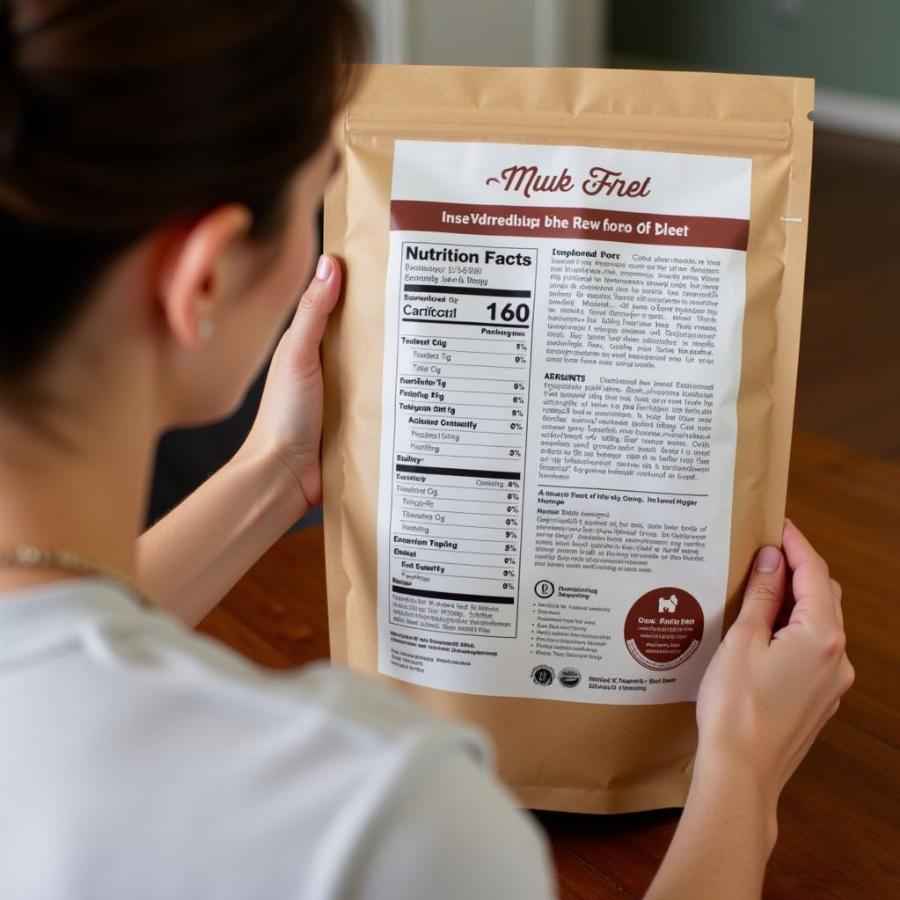Dehydrated raw dog food is growing in popularity among pet owners seeking a convenient and nutritious alternative to traditional kibble or raw feeding. But what exactly is dehydrated raw dog food, and is it the right choice for your furry friend? This comprehensive guide will explore everything you need to know about dehydrated raw dog food, from its benefits and drawbacks to choosing the best option for your canine companion.
What is Dehydrated Raw Dog Food?
Dehydrated raw dog food is made from raw ingredients that have been gently cooked at low temperatures to remove moisture. This process helps to preserve the nutrients and enzymes often lost in traditional kibble processing. The result is a shelf-stable, nutrient-rich food that can be easily rehydrated with water before serving.
Benefits of Dehydrated Raw Dog Food
Dehydrated raw dog food offers a range of potential benefits for dogs, including:
- Increased Nutrient Availability: The gentle dehydration process helps preserve vitamins, minerals, and enzymes that can be destroyed during high-heat cooking.
- Improved Digestion: Raw food, even when dehydrated, is often easier for dogs to digest than kibble, thanks to its natural enzymes and lack of fillers.
- Shinier Coat and Healthier Skin: Many pet owners report seeing improvements in their dog’s skin and coat health after switching to a dehydrated raw diet.
- Increased Energy Levels: The high-quality protein and nutrient content of dehydrated raw food can contribute to increased energy and vitality.
- Convenience: Unlike traditional raw feeding, which requires careful handling and storage, dehydrated raw food offers a convenient and shelf-stable option.
Potential Drawbacks of Dehydrated Raw Dog Food
While there are many benefits to feeding dehydrated raw, it’s essential to be aware of potential drawbacks:
- Cost: Dehydrated raw food can be more expensive than traditional kibble.
- Preparation Time: Although more convenient than raw feeding, dehydrated food still requires rehydration with water before serving.
- Potential for Bacteria: As with any raw meat product, handling dehydrated raw food requires proper hygiene to minimize bacterial contamination.
Choosing the Right Dehydrated Raw Dog Food
Not all dehydrated raw dog foods are created equal. Here’s what to look for when choosing a brand:
- High-Quality Ingredients: Look for brands that use human-grade ingredients, with a focus on whole meat sources, fruits, vegetables, and healthy fats.
- Complete and Balanced Nutrition: Ensure the food meets AAFCO (Association of American Feed Control Officials) standards for complete and balanced nutrition for your dog’s life stage.
- Limited Ingredients: For dogs with allergies or sensitivities, consider a limited-ingredient formula.
- No Artificial Additives: Avoid brands that contain artificial colors, flavors, preservatives, or fillers.
 Pet owner examining the label of a dehydrated raw dog food bag.
Pet owner examining the label of a dehydrated raw dog food bag.
Transitioning to Dehydrated Raw Food
When switching your dog to a new food, it’s essential to transition gradually to avoid digestive upset. Start by introducing a small amount of dehydrated raw food mixed with your dog’s current food. Gradually increase the ratio of raw food over 7-10 days until your dog is fully transitioned.
Dehydrated Raw vs. Other Food Types
- Dehydrated Raw vs. Kibble: Dehydrated raw food offers higher nutrient bioavailability and digestibility compared to most kibble brands.
- Dehydrated Raw vs. Freeze-Dried Raw: Both are minimally processed, but freeze-dried food has a longer shelf life and doesn’t require rehydration.
Is Dehydrated Raw Dog Food Right for My Dog?
Dehydrated raw food can be an excellent option for many dogs, but it’s essential to consider your dog’s individual needs and consult with your veterinarian. They can help you determine if dehydrated raw aligns with your dog’s health condition, dietary requirements, and lifestyle.
Conclusion
Dehydrated raw dog food offers a convenient and nutritious way to provide your furry friend with a diet closer to what nature intended. By understanding the benefits, drawbacks, and factors to consider when choosing a brand, you can make an informed decision about whether dehydrated raw is the right choice for your canine companion.
FAQs
1. How do I store dehydrated raw dog food?
Store unopened bags in a cool, dry place. Once opened, reseal the bag tightly and store it in a cool, dry place or in the freezer for extended freshness.
2. Can I feed my puppy dehydrated raw dog food?
Yes, but choose a formula specifically designed for puppies to ensure they receive the appropriate nutrients for growth and development.
3. Do I need to add supplements to a dehydrated raw diet?
A complete and balanced dehydrated raw food should provide all the necessary nutrients. However, it’s best to consult your veterinarian for personalized advice.
4. Can I mix dehydrated raw food with kibble?
While it’s possible, it’s generally not recommended to mix different types of food as it can disrupt digestion.
5. Where can I buy dehydrated raw dog food?
Dehydrated raw food can be found at many pet supply stores, online retailers, and some veterinary clinics.
Still have questions about dehydrated raw dog food?
For tailored advice on finding the best dehydrated raw options for your furry friend, reach out to us at Beaut Dogs. Email [email protected] for personalized recommendations and expert guidance.
Beaut Dogs is your trusted source for all things related to caring for your canine companion. We are committed to providing you with accurate, insightful, and engaging content to help you make the best decisions for your dog’s health and happiness.